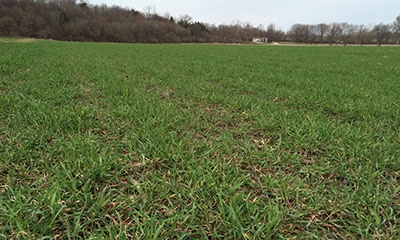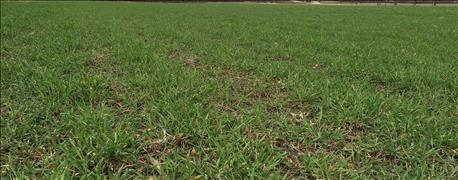August 8, 2016

Fall is fast approaching, and Iowa farmers want to make sure their soil and water are protected when corn and soybeans are harvested. Cover crops keep roots in the ground year-round, holding soil in place and keeping nutrients like nitrate out of the state’s creeks and rivers. But which cover crop is best?
To help answer that question, members of Practical Farmers of Iowa have been conducting on-farm research for the past five years to evaluate the performance of cover crops.

COVER CROP VARIETY TRIAL: For the past five years, PFI has been conducting on-farm research to evaluate how various cover crop species perform in a corn-soybean rotation. Results show cereal rye is the most consistent performer, but the research has revealed other surprising insights.
Last fall, nine cooperating farmers seeded cover crops into 16 fields across the state. These farmers screened 13 cover crop entries – grasses, legumes and brassicas – to determine fall and spring ground cover offered by the plants. Entries were hand-seeded into standing corn and soybean crops to simulate aerial seeding.
On-farm tests show cereal rye is the most consistent performer
“This research provides an easy way to see whether a potential cover crop is going to do well in your area,” says Chad Ingels, who raises corn, soybeans and hogs near Randalia in northeast Iowa. He is one of the participants in the project. Ingels says he plants cover crops to reduce erosion and nutrient loss, and to improve soil quality.
Read the full report and results of the variety trials from previous years by visiting practicalfarmers.org/research-reports and searching for “Cover Crop Variety Trial.”
Results show that cereal rye is the most consistent performer in a corn and soybean rotation, producing more fall ground cover, then overwintering well and producing good spring ground cover. “We found that cereal rye is probably the best at this point for our operation,” says Ingels. “However, wheat seems to work, too, and this past year, barley also seemed to work pretty well.” He plants cereal rye as a cover crop on about three-fourths of his acres, and winter wheat on the rest.
Cereal rye typically provided the most fall and spring cover
In the 2015-2016 trial season, cereal rye typically provided the most fall and spring cover across all locations. At some locations, winter wheat, winter triticale and winter barley provided just as much cover as cereal rye. Oats also provided good fall ground cover at most sites. Other key findings from the past four years reveal that:
* Annual ryegrass generally provided less consistent cover than the other grass and small grains species.
* Brassica cover crops – such as radishes, turnips, rapeseed and mustard – performed better in 2015-2016 than in the past, likely because of optimal moisture and temperature conditions.
* Of the brassicas, brown mustard consistently shows promise as a non-small-grains fall cover crop.
* Hairy vetch, the lone legume crop studied, consistently overwintered across all locations in the 2015-16 period only. This was the first recorded instance of this happening universally across locations in the past four years. Attempting to use a legume cover crop to fix nitrogen between corn and soybeans is challenging due to the limited heat units left in the season to help it get established when seeded in early to mid-September.
PFI strengthens farms and communities through farmer-led investigation and information-sharing. Our values include: welcoming everyone; creativity, collaboration and community; viable farms now and for future generations; and stewardship and ecology. Founded in 1985, farmers in the network raise corn, soybeans, livestock, hay, fruits and vegetables, and more. To learn more, visit practicalfarmers.org.
You May Also Like




